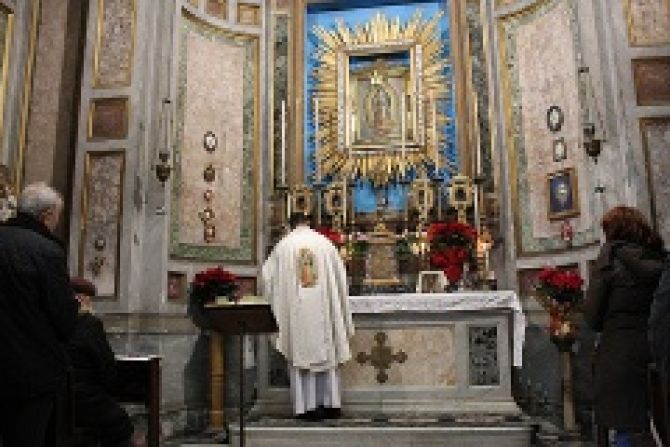Rome, Italy, Dec 12, 2013 / 15:38 pm
Several hundred yards from the heart of the ancient forum, devotees are gathering in the run-down Basilica of San Nicola in Carcere today where one of the first copies of the Virgin of Guadalupe is on display.
"Practically, this icon of our lady isn't the original but the second icon of Our Lady that was brought with some difficulty to Italy," recounts Fiorella Silvestri after the 11a.m. Mass. She's one of several dozen core members of the prayer group that meets every twelfth of the month at the shrine.
The Dec. 12 feast of Our Lady of Guadalupe brings more of a crowd than usual – there are nearly 50. At the same time, as many as six million people are making the pilgrimage to the original back in Mexico while a 20,000 man-strong security force is guaranteeing their safety.
Here, the basilica's lone young doorman is distracted as he assembles a tarpaulin-covered nativity scene in a dark corner of the church.
This is Rome's shrine to Our Lady of Guadalupe.
With its humble appearance and the peeling paint on the stone and plaster walls, this is another of Rome's great treasures. And as many of the myriad treasures that find a home in this city, not many know about it.
The image of Our Lady – which is believed to be the work of the 18th century maestro Miguel Cabrera – was brought to Rome by two Jesuit priests around 1770 and placed in St. Mary of the Vineyards Church at the base of the forum's Capitoline Hill. Several years later, it was moved 100 yards down the hill to San Nicola where it remains.
The small basilica itself was built using the ruins and foundations of nearby pagan temples. The eclectic columns holding up the ceiling are the originals, some graffitied with millennial Latin scribblings.
Construction on the church started just 68 years after the image of Our Lady miraculously appeared along with Castillian roses in Juan Diego's tilma in 1531.
The copy that now adorns chapel altarpiece is just small, measuring no more than 2 by 3 feet at most. The original at Mount Tepeyac just outside Mexico City is imprinted on a cape made of plant fibers measuring 5.5 by 4.6 feet.
Whereas in Mexico City, Our Lady is visited by between 18 and 20 million pilgrims a year. At San Nicola, she's tucked away in a side altar and sees the few visitors that trickle through to see the ancient Roman ruins accessible through the crypts of the Church.
"I don't know why the devotion hasn't grown more. We've tried in every way to increase interest… but it hasn't grown any more than it has," said Silvestri, who travelled in from the nearby city of Ostia for the occasion. She was one of the first members of the local Guadalupe prayer group.
"Unfortunately, this church is rather poorly take care of. Sorry if I say so." Rebeca Vasquez Flores, another local member, originally from San Agustin Mimbres, Mexico.
She's been coming to the church since she arrived in Rome for work 28 years ago. "What am I doing here? Well, I've come to venerate the Virgin. I really like to come when I have time, because I don't always have time."
"In my simplicity, I can tell you that God is in all of us and Our Lady cares for us and protects us as her children," says Flores.
She was the only Mexican there besides the celebrating priest, Fr. Jose Luis Garcia Bernal from Guzman in Jalisco state.
He's in his second year as a student in Rome, celebrating the Guadalupan feast away from home for the second time. He said he sees the same fervor as there is back in Mexico here, however. "Although this is not a very big celebration," he said, "I've perceived the great gesture of devotion and dedication to Our Lady of Guadalupe."
He was particularly struck by Italians singing the Spanish-language "La Guadalupana" hymn at the end of Mass.
"Perhaps in the form there are some differences (between this and the celebration in Mexico) but in terms of the faith and encountering Jesus in the Eucharist," said Fr. Garcia Bernal, "I don't think there are any differences."



